ICT393 Report: A Comparison of Scrum and RUP System Development
VerifiedAdded on 2023/06/04
|11
|2204
|58
Report
AI Summary
This report provides a detailed comparison of Scrum and Rational Unified Process (RUP) methodologies for system development. It outlines the advantages and disadvantages of each approach, highlighting their iterative nature and suitability for different project types. Scrum is presented as an agile framework emphasizing teamwork and adaptability, while RUP is described as a more structured process with defined stages. The report includes a comparison table summarizing key differences and offers recommendations for choosing the appropriate methodology based on project requirements and organizational context. The author advocates for the use of Scrum in Innovative Solutions for its incremental approach and enhanced communication, ultimately leading to cost savings and improved product quality. Desklib offers this student assignment and many more resources for students.
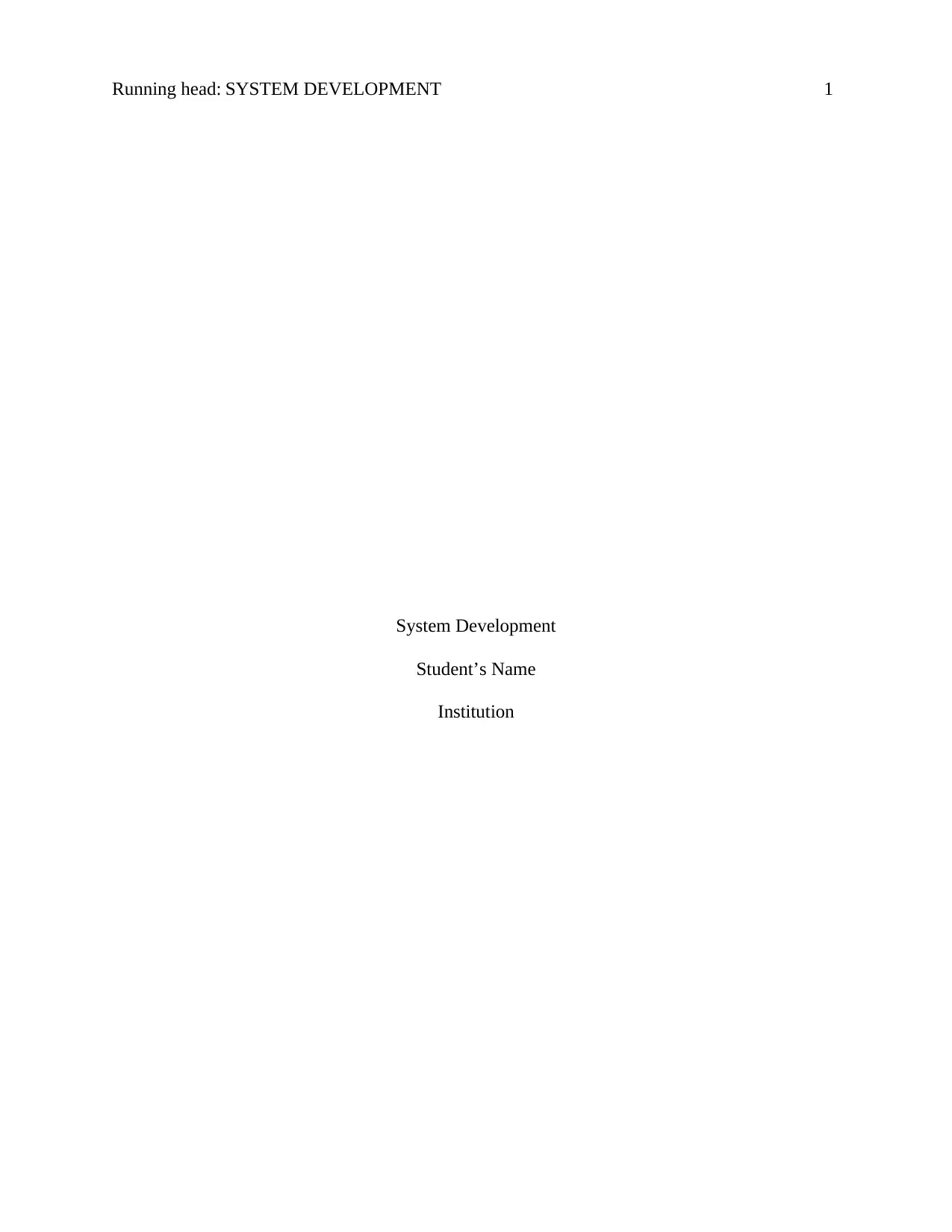
Running head: SYSTEM DEVELOPMENT 1
System Development
Student’s Name
Institution
System Development
Student’s Name
Institution
Paraphrase This Document
Need a fresh take? Get an instant paraphrase of this document with our AI Paraphraser
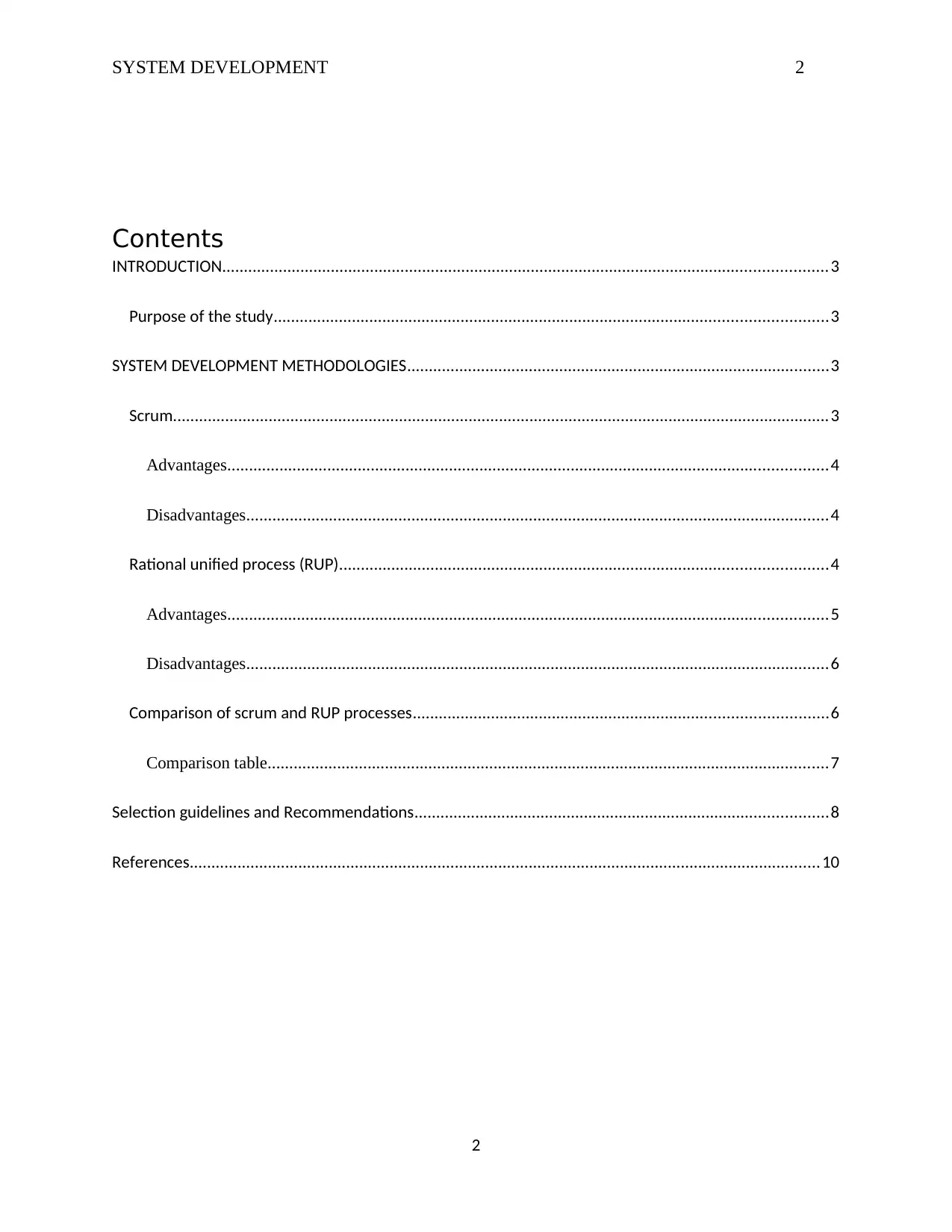
SYSTEM DEVELOPMENT 2
Contents
INTRODUCTION...........................................................................................................................................3
Purpose of the study...............................................................................................................................3
SYSTEM DEVELOPMENT METHODOLOGIES.................................................................................................3
Scrum.......................................................................................................................................................3
Advantages..........................................................................................................................................4
Disadvantages......................................................................................................................................4
Rational unified process (RUP)................................................................................................................4
Advantages..........................................................................................................................................5
Disadvantages......................................................................................................................................6
Comparison of scrum and RUP processes...............................................................................................6
Comparison table.................................................................................................................................7
Selection guidelines and Recommendations...............................................................................................8
References.................................................................................................................................................10
2
Contents
INTRODUCTION...........................................................................................................................................3
Purpose of the study...............................................................................................................................3
SYSTEM DEVELOPMENT METHODOLOGIES.................................................................................................3
Scrum.......................................................................................................................................................3
Advantages..........................................................................................................................................4
Disadvantages......................................................................................................................................4
Rational unified process (RUP)................................................................................................................4
Advantages..........................................................................................................................................5
Disadvantages......................................................................................................................................6
Comparison of scrum and RUP processes...............................................................................................6
Comparison table.................................................................................................................................7
Selection guidelines and Recommendations...............................................................................................8
References.................................................................................................................................................10
2
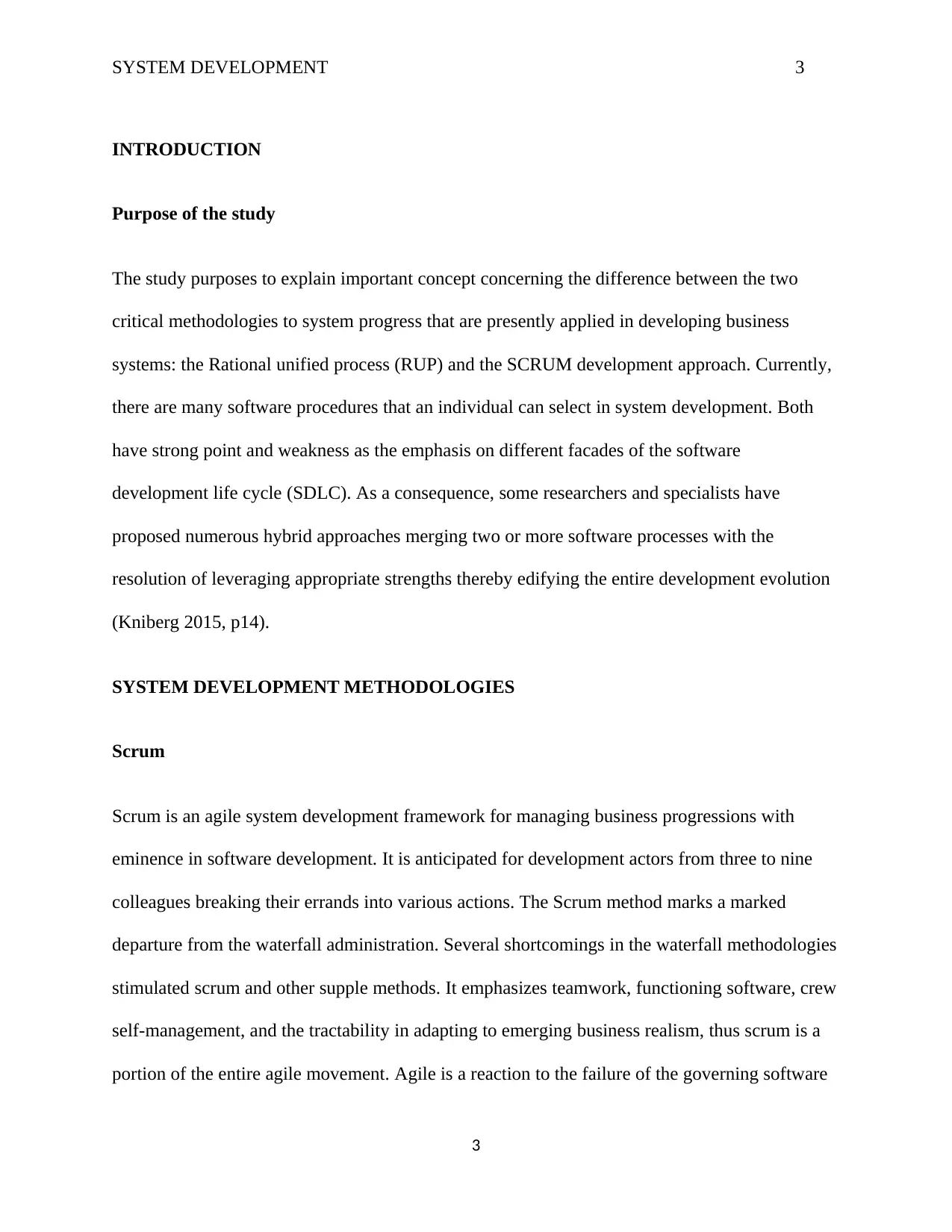
SYSTEM DEVELOPMENT 3
INTRODUCTION
Purpose of the study
The study purposes to explain important concept concerning the difference between the two
critical methodologies to system progress that are presently applied in developing business
systems: the Rational unified process (RUP) and the SCRUM development approach. Currently,
there are many software procedures that an individual can select in system development. Both
have strong point and weakness as the emphasis on different facades of the software
development life cycle (SDLC). As a consequence, some researchers and specialists have
proposed numerous hybrid approaches merging two or more software processes with the
resolution of leveraging appropriate strengths thereby edifying the entire development evolution
(Kniberg 2015, p14).
SYSTEM DEVELOPMENT METHODOLOGIES
Scrum
Scrum is an agile system development framework for managing business progressions with
eminence in software development. It is anticipated for development actors from three to nine
colleagues breaking their errands into various actions. The Scrum method marks a marked
departure from the waterfall administration. Several shortcomings in the waterfall methodologies
stimulated scrum and other supple methods. It emphasizes teamwork, functioning software, crew
self-management, and the tractability in adapting to emerging business realism, thus scrum is a
portion of the entire agile movement. Agile is a reaction to the failure of the governing software
3
INTRODUCTION
Purpose of the study
The study purposes to explain important concept concerning the difference between the two
critical methodologies to system progress that are presently applied in developing business
systems: the Rational unified process (RUP) and the SCRUM development approach. Currently,
there are many software procedures that an individual can select in system development. Both
have strong point and weakness as the emphasis on different facades of the software
development life cycle (SDLC). As a consequence, some researchers and specialists have
proposed numerous hybrid approaches merging two or more software processes with the
resolution of leveraging appropriate strengths thereby edifying the entire development evolution
(Kniberg 2015, p14).
SYSTEM DEVELOPMENT METHODOLOGIES
Scrum
Scrum is an agile system development framework for managing business progressions with
eminence in software development. It is anticipated for development actors from three to nine
colleagues breaking their errands into various actions. The Scrum method marks a marked
departure from the waterfall administration. Several shortcomings in the waterfall methodologies
stimulated scrum and other supple methods. It emphasizes teamwork, functioning software, crew
self-management, and the tractability in adapting to emerging business realism, thus scrum is a
portion of the entire agile movement. Agile is a reaction to the failure of the governing software
3
⊘ This is a preview!⊘
Do you want full access?
Subscribe today to unlock all pages.

Trusted by 1+ million students worldwide
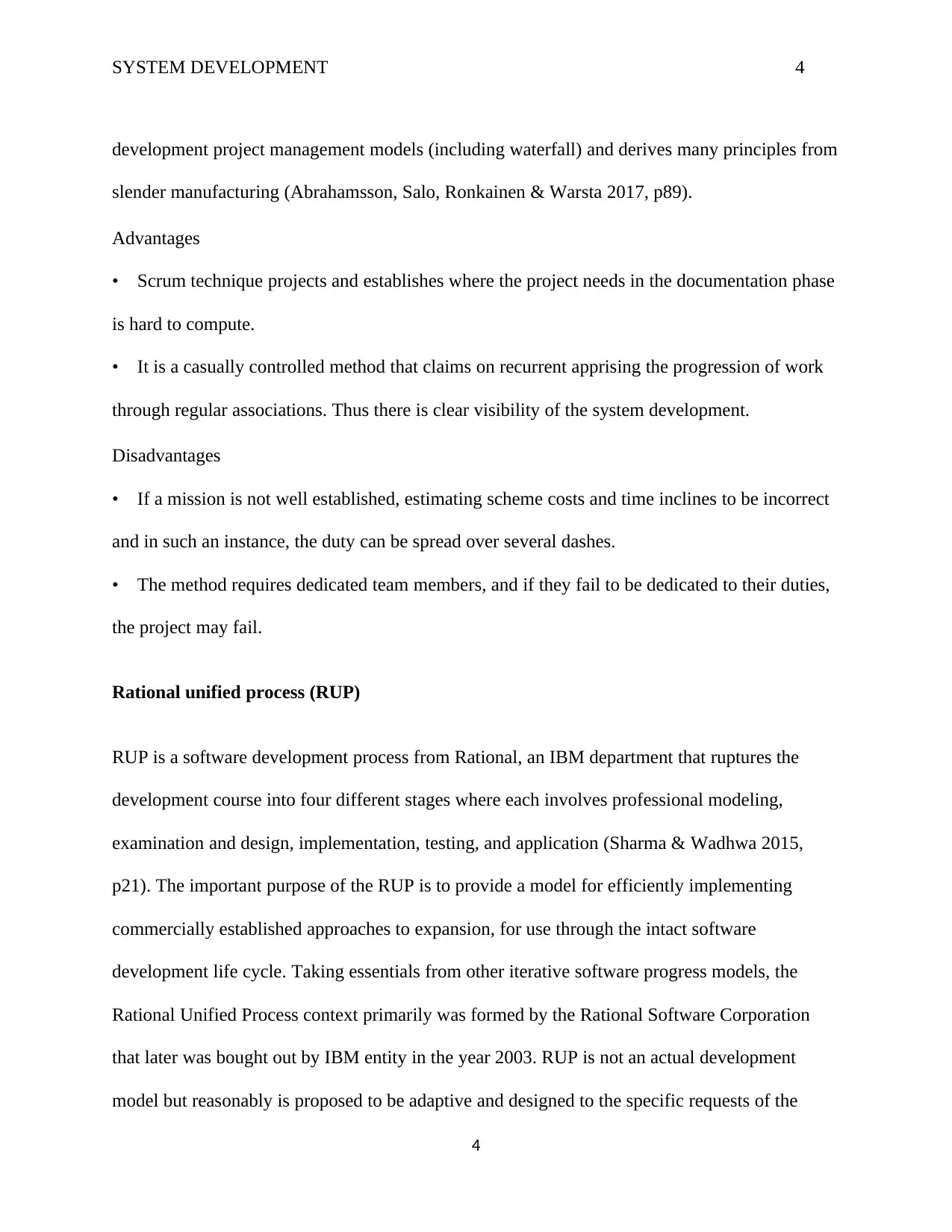
SYSTEM DEVELOPMENT 4
development project management models (including waterfall) and derives many principles from
slender manufacturing (Abrahamsson, Salo, Ronkainen & Warsta 2017, p89).
Advantages
• Scrum technique projects and establishes where the project needs in the documentation phase
is hard to compute.
• It is a casually controlled method that claims on recurrent apprising the progression of work
through regular associations. Thus there is clear visibility of the system development.
Disadvantages
• If a mission is not well established, estimating scheme costs and time inclines to be incorrect
and in such an instance, the duty can be spread over several dashes.
• The method requires dedicated team members, and if they fail to be dedicated to their duties,
the project may fail.
Rational unified process (RUP)
RUP is a software development process from Rational, an IBM department that ruptures the
development course into four different stages where each involves professional modeling,
examination and design, implementation, testing, and application (Sharma & Wadhwa 2015,
p21). The important purpose of the RUP is to provide a model for efficiently implementing
commercially established approaches to expansion, for use through the intact software
development life cycle. Taking essentials from other iterative software progress models, the
Rational Unified Process context primarily was formed by the Rational Software Corporation
that later was bought out by IBM entity in the year 2003. RUP is not an actual development
model but reasonably is proposed to be adaptive and designed to the specific requests of the
4
development project management models (including waterfall) and derives many principles from
slender manufacturing (Abrahamsson, Salo, Ronkainen & Warsta 2017, p89).
Advantages
• Scrum technique projects and establishes where the project needs in the documentation phase
is hard to compute.
• It is a casually controlled method that claims on recurrent apprising the progression of work
through regular associations. Thus there is clear visibility of the system development.
Disadvantages
• If a mission is not well established, estimating scheme costs and time inclines to be incorrect
and in such an instance, the duty can be spread over several dashes.
• The method requires dedicated team members, and if they fail to be dedicated to their duties,
the project may fail.
Rational unified process (RUP)
RUP is a software development process from Rational, an IBM department that ruptures the
development course into four different stages where each involves professional modeling,
examination and design, implementation, testing, and application (Sharma & Wadhwa 2015,
p21). The important purpose of the RUP is to provide a model for efficiently implementing
commercially established approaches to expansion, for use through the intact software
development life cycle. Taking essentials from other iterative software progress models, the
Rational Unified Process context primarily was formed by the Rational Software Corporation
that later was bought out by IBM entity in the year 2003. RUP is not an actual development
model but reasonably is proposed to be adaptive and designed to the specific requests of the
4
Paraphrase This Document
Need a fresh take? Get an instant paraphrase of this document with our AI Paraphraser
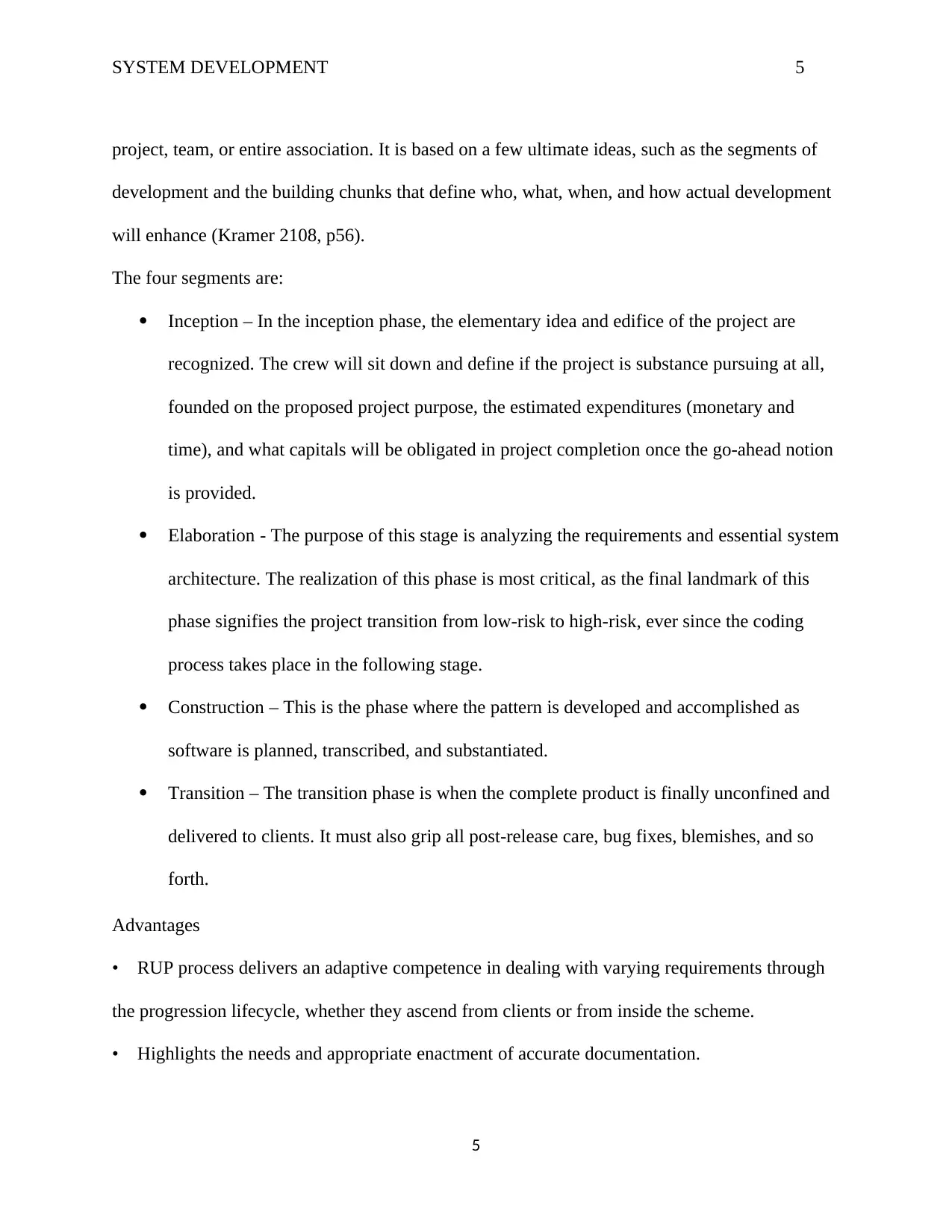
SYSTEM DEVELOPMENT 5
project, team, or entire association. It is based on a few ultimate ideas, such as the segments of
development and the building chunks that define who, what, when, and how actual development
will enhance (Kramer 2108, p56).
The four segments are:
Inception – In the inception phase, the elementary idea and edifice of the project are
recognized. The crew will sit down and define if the project is substance pursuing at all,
founded on the proposed project purpose, the estimated expenditures (monetary and
time), and what capitals will be obligated in project completion once the go-ahead notion
is provided.
Elaboration - The purpose of this stage is analyzing the requirements and essential system
architecture. The realization of this phase is most critical, as the final landmark of this
phase signifies the project transition from low-risk to high-risk, ever since the coding
process takes place in the following stage.
Construction – This is the phase where the pattern is developed and accomplished as
software is planned, transcribed, and substantiated.
Transition – The transition phase is when the complete product is finally unconfined and
delivered to clients. It must also grip all post-release care, bug fixes, blemishes, and so
forth.
Advantages
• RUP process delivers an adaptive competence in dealing with varying requirements through
the progression lifecycle, whether they ascend from clients or from inside the scheme.
• Highlights the needs and appropriate enactment of accurate documentation.
5
project, team, or entire association. It is based on a few ultimate ideas, such as the segments of
development and the building chunks that define who, what, when, and how actual development
will enhance (Kramer 2108, p56).
The four segments are:
Inception – In the inception phase, the elementary idea and edifice of the project are
recognized. The crew will sit down and define if the project is substance pursuing at all,
founded on the proposed project purpose, the estimated expenditures (monetary and
time), and what capitals will be obligated in project completion once the go-ahead notion
is provided.
Elaboration - The purpose of this stage is analyzing the requirements and essential system
architecture. The realization of this phase is most critical, as the final landmark of this
phase signifies the project transition from low-risk to high-risk, ever since the coding
process takes place in the following stage.
Construction – This is the phase where the pattern is developed and accomplished as
software is planned, transcribed, and substantiated.
Transition – The transition phase is when the complete product is finally unconfined and
delivered to clients. It must also grip all post-release care, bug fixes, blemishes, and so
forth.
Advantages
• RUP process delivers an adaptive competence in dealing with varying requirements through
the progression lifecycle, whether they ascend from clients or from inside the scheme.
• Highlights the needs and appropriate enactment of accurate documentation.
5
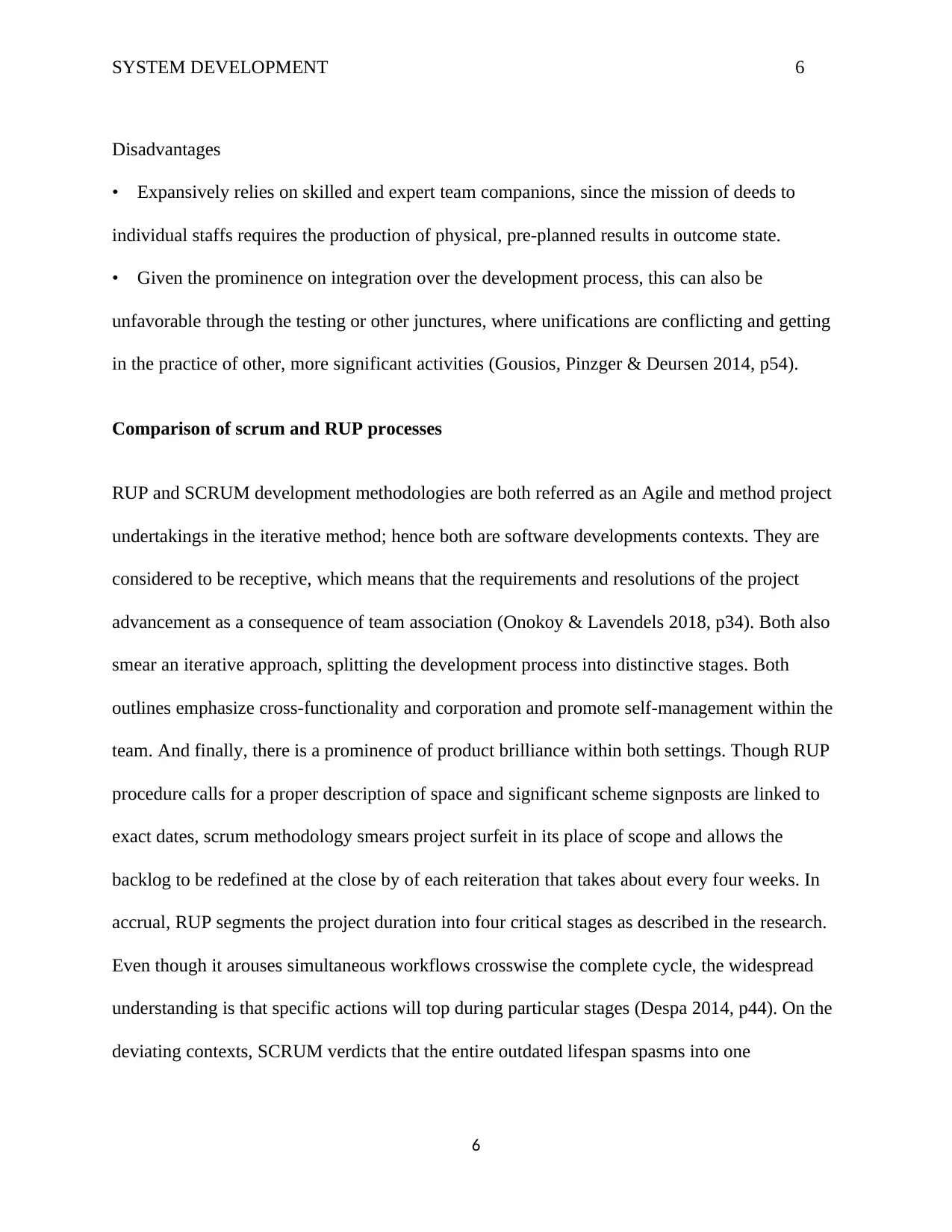
SYSTEM DEVELOPMENT 6
Disadvantages
• Expansively relies on skilled and expert team companions, since the mission of deeds to
individual staffs requires the production of physical, pre-planned results in outcome state.
• Given the prominence on integration over the development process, this can also be
unfavorable through the testing or other junctures, where unifications are conflicting and getting
in the practice of other, more significant activities (Gousios, Pinzger & Deursen 2014, p54).
Comparison of scrum and RUP processes
RUP and SCRUM development methodologies are both referred as an Agile and method project
undertakings in the iterative method; hence both are software developments contexts. They are
considered to be receptive, which means that the requirements and resolutions of the project
advancement as a consequence of team association (Onokoy & Lavendels 2018, p34). Both also
smear an iterative approach, splitting the development process into distinctive stages. Both
outlines emphasize cross-functionality and corporation and promote self-management within the
team. And finally, there is a prominence of product brilliance within both settings. Though RUP
procedure calls for a proper description of space and significant scheme signposts are linked to
exact dates, scrum methodology smears project surfeit in its place of scope and allows the
backlog to be redefined at the close by of each reiteration that takes about every four weeks. In
accrual, RUP segments the project duration into four critical stages as described in the research.
Even though it arouses simultaneous workflows crosswise the complete cycle, the widespread
understanding is that specific actions will top during particular stages (Despa 2014, p44). On the
deviating contexts, SCRUM verdicts that the entire outdated lifespan spasms into one
6
Disadvantages
• Expansively relies on skilled and expert team companions, since the mission of deeds to
individual staffs requires the production of physical, pre-planned results in outcome state.
• Given the prominence on integration over the development process, this can also be
unfavorable through the testing or other junctures, where unifications are conflicting and getting
in the practice of other, more significant activities (Gousios, Pinzger & Deursen 2014, p54).
Comparison of scrum and RUP processes
RUP and SCRUM development methodologies are both referred as an Agile and method project
undertakings in the iterative method; hence both are software developments contexts. They are
considered to be receptive, which means that the requirements and resolutions of the project
advancement as a consequence of team association (Onokoy & Lavendels 2018, p34). Both also
smear an iterative approach, splitting the development process into distinctive stages. Both
outlines emphasize cross-functionality and corporation and promote self-management within the
team. And finally, there is a prominence of product brilliance within both settings. Though RUP
procedure calls for a proper description of space and significant scheme signposts are linked to
exact dates, scrum methodology smears project surfeit in its place of scope and allows the
backlog to be redefined at the close by of each reiteration that takes about every four weeks. In
accrual, RUP segments the project duration into four critical stages as described in the research.
Even though it arouses simultaneous workflows crosswise the complete cycle, the widespread
understanding is that specific actions will top during particular stages (Despa 2014, p44). On the
deviating contexts, SCRUM verdicts that the entire outdated lifespan spasms into one
6
⊘ This is a preview!⊘
Do you want full access?
Subscribe today to unlock all pages.

Trusted by 1+ million students worldwide

SYSTEM DEVELOPMENT 7
reaffirmation. In other words, the ability for one iteration of an incantation tends recognition, and
then the complete cycle occurs within one iteration.
Comparison table
RUP SCRUM
Methodology Iterative Iterative
Timeline Recommended for large and long-term
edge level schemes with medium-to-high
complexity.
Suggested for rapid enrichments and
establishments that are not reliant on a
bound timelines.
Category of
Project/Invention
A number of Artifacts is present. Among
them are; extension plan, Vision/Scope
Article, Formal functional requirements
package, scheme design document, among
others.
Operative software is the only official
artifact.
Scope RUP scope is defined before
commencement of the project and
documented in the range document.
In the case of SCRUM, it applies a
project backlog that is re-evaluated at
each sprint completion.
Planning Project plan is prescribed and related with
multiple reviews. The idea is end-date
resolute and also has middle milestones.
There is no end-to-end system plan as
each succeeding iteration strategy is
enhanced at the termination of the
7
reaffirmation. In other words, the ability for one iteration of an incantation tends recognition, and
then the complete cycle occurs within one iteration.
Comparison table
RUP SCRUM
Methodology Iterative Iterative
Timeline Recommended for large and long-term
edge level schemes with medium-to-high
complexity.
Suggested for rapid enrichments and
establishments that are not reliant on a
bound timelines.
Category of
Project/Invention
A number of Artifacts is present. Among
them are; extension plan, Vision/Scope
Article, Formal functional requirements
package, scheme design document, among
others.
Operative software is the only official
artifact.
Scope RUP scope is defined before
commencement of the project and
documented in the range document.
In the case of SCRUM, it applies a
project backlog that is re-evaluated at
each sprint completion.
Planning Project plan is prescribed and related with
multiple reviews. The idea is end-date
resolute and also has middle milestones.
There is no end-to-end system plan as
each succeeding iteration strategy is
enhanced at the termination of the
7
Paraphrase This Document
Need a fresh take? Get an instant paraphrase of this document with our AI Paraphraser
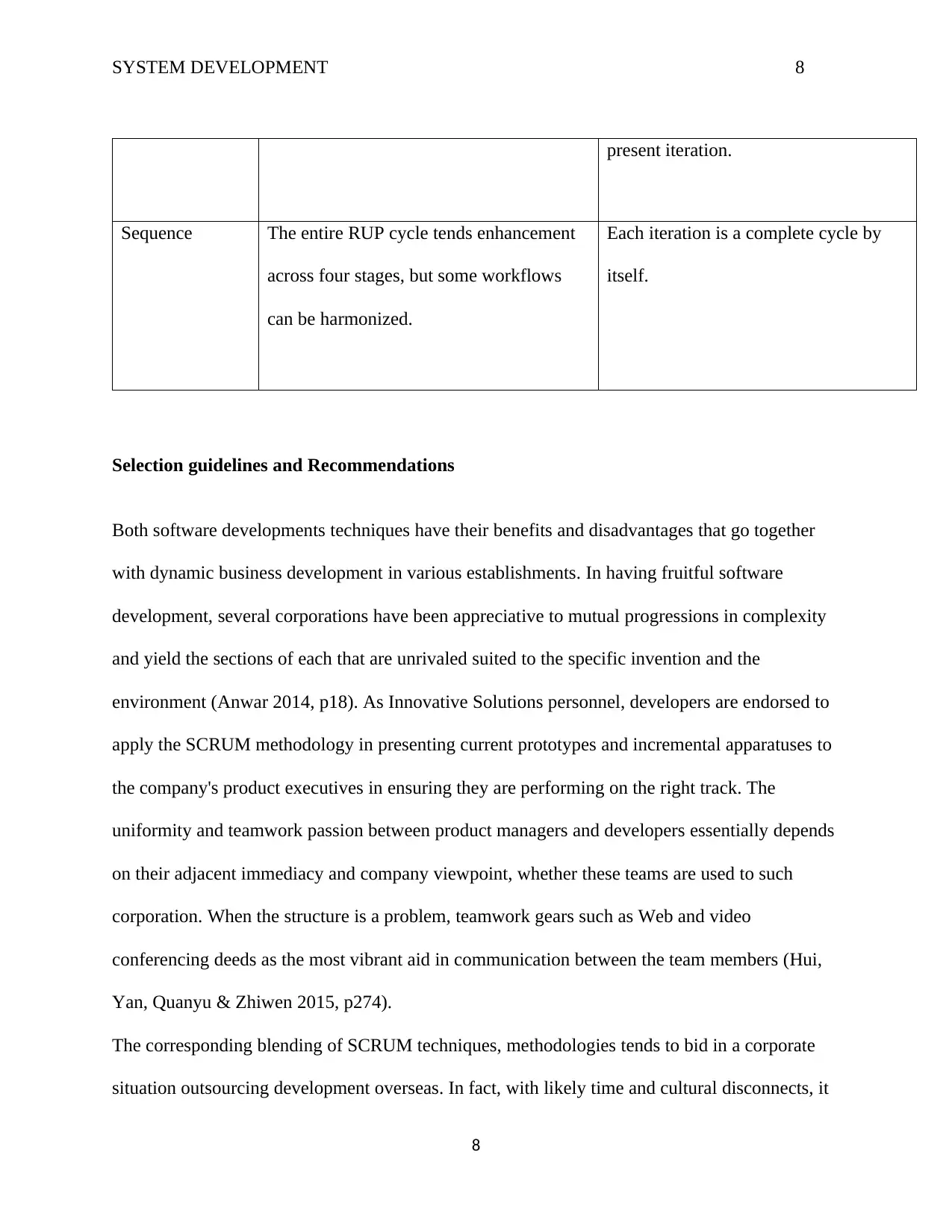
SYSTEM DEVELOPMENT 8
present iteration.
Sequence The entire RUP cycle tends enhancement
across four stages, but some workflows
can be harmonized.
Each iteration is a complete cycle by
itself.
Selection guidelines and Recommendations
Both software developments techniques have their benefits and disadvantages that go together
with dynamic business development in various establishments. In having fruitful software
development, several corporations have been appreciative to mutual progressions in complexity
and yield the sections of each that are unrivaled suited to the specific invention and the
environment (Anwar 2014, p18). As Innovative Solutions personnel, developers are endorsed to
apply the SCRUM methodology in presenting current prototypes and incremental apparatuses to
the company's product executives in ensuring they are performing on the right track. The
uniformity and teamwork passion between product managers and developers essentially depends
on their adjacent immediacy and company viewpoint, whether these teams are used to such
corporation. When the structure is a problem, teamwork gears such as Web and video
conferencing deeds as the most vibrant aid in communication between the team members (Hui,
Yan, Quanyu & Zhiwen 2015, p274).
The corresponding blending of SCRUM techniques, methodologies tends to bid in a corporate
situation outsourcing development overseas. In fact, with likely time and cultural disconnects, it
8
present iteration.
Sequence The entire RUP cycle tends enhancement
across four stages, but some workflows
can be harmonized.
Each iteration is a complete cycle by
itself.
Selection guidelines and Recommendations
Both software developments techniques have their benefits and disadvantages that go together
with dynamic business development in various establishments. In having fruitful software
development, several corporations have been appreciative to mutual progressions in complexity
and yield the sections of each that are unrivaled suited to the specific invention and the
environment (Anwar 2014, p18). As Innovative Solutions personnel, developers are endorsed to
apply the SCRUM methodology in presenting current prototypes and incremental apparatuses to
the company's product executives in ensuring they are performing on the right track. The
uniformity and teamwork passion between product managers and developers essentially depends
on their adjacent immediacy and company viewpoint, whether these teams are used to such
corporation. When the structure is a problem, teamwork gears such as Web and video
conferencing deeds as the most vibrant aid in communication between the team members (Hui,
Yan, Quanyu & Zhiwen 2015, p274).
The corresponding blending of SCRUM techniques, methodologies tends to bid in a corporate
situation outsourcing development overseas. In fact, with likely time and cultural disconnects, it
8
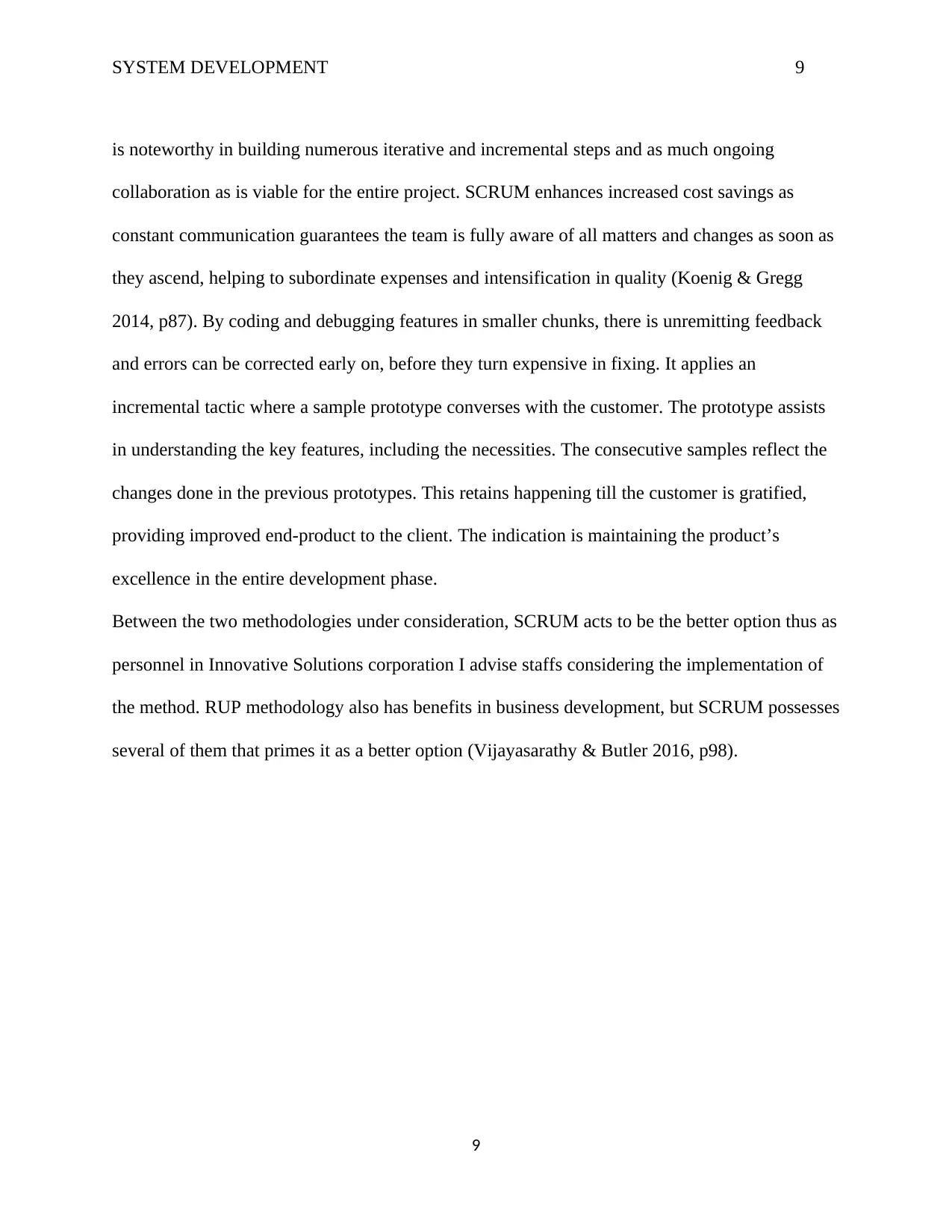
SYSTEM DEVELOPMENT 9
is noteworthy in building numerous iterative and incremental steps and as much ongoing
collaboration as is viable for the entire project. SCRUM enhances increased cost savings as
constant communication guarantees the team is fully aware of all matters and changes as soon as
they ascend, helping to subordinate expenses and intensification in quality (Koenig & Gregg
2014, p87). By coding and debugging features in smaller chunks, there is unremitting feedback
and errors can be corrected early on, before they turn expensive in fixing. It applies an
incremental tactic where a sample prototype converses with the customer. The prototype assists
in understanding the key features, including the necessities. The consecutive samples reflect the
changes done in the previous prototypes. This retains happening till the customer is gratified,
providing improved end-product to the client. The indication is maintaining the product’s
excellence in the entire development phase.
Between the two methodologies under consideration, SCRUM acts to be the better option thus as
personnel in Innovative Solutions corporation I advise staffs considering the implementation of
the method. RUP methodology also has benefits in business development, but SCRUM possesses
several of them that primes it as a better option (Vijayasarathy & Butler 2016, p98).
9
is noteworthy in building numerous iterative and incremental steps and as much ongoing
collaboration as is viable for the entire project. SCRUM enhances increased cost savings as
constant communication guarantees the team is fully aware of all matters and changes as soon as
they ascend, helping to subordinate expenses and intensification in quality (Koenig & Gregg
2014, p87). By coding and debugging features in smaller chunks, there is unremitting feedback
and errors can be corrected early on, before they turn expensive in fixing. It applies an
incremental tactic where a sample prototype converses with the customer. The prototype assists
in understanding the key features, including the necessities. The consecutive samples reflect the
changes done in the previous prototypes. This retains happening till the customer is gratified,
providing improved end-product to the client. The indication is maintaining the product’s
excellence in the entire development phase.
Between the two methodologies under consideration, SCRUM acts to be the better option thus as
personnel in Innovative Solutions corporation I advise staffs considering the implementation of
the method. RUP methodology also has benefits in business development, but SCRUM possesses
several of them that primes it as a better option (Vijayasarathy & Butler 2016, p98).
9
⊘ This is a preview!⊘
Do you want full access?
Subscribe today to unlock all pages.

Trusted by 1+ million students worldwide
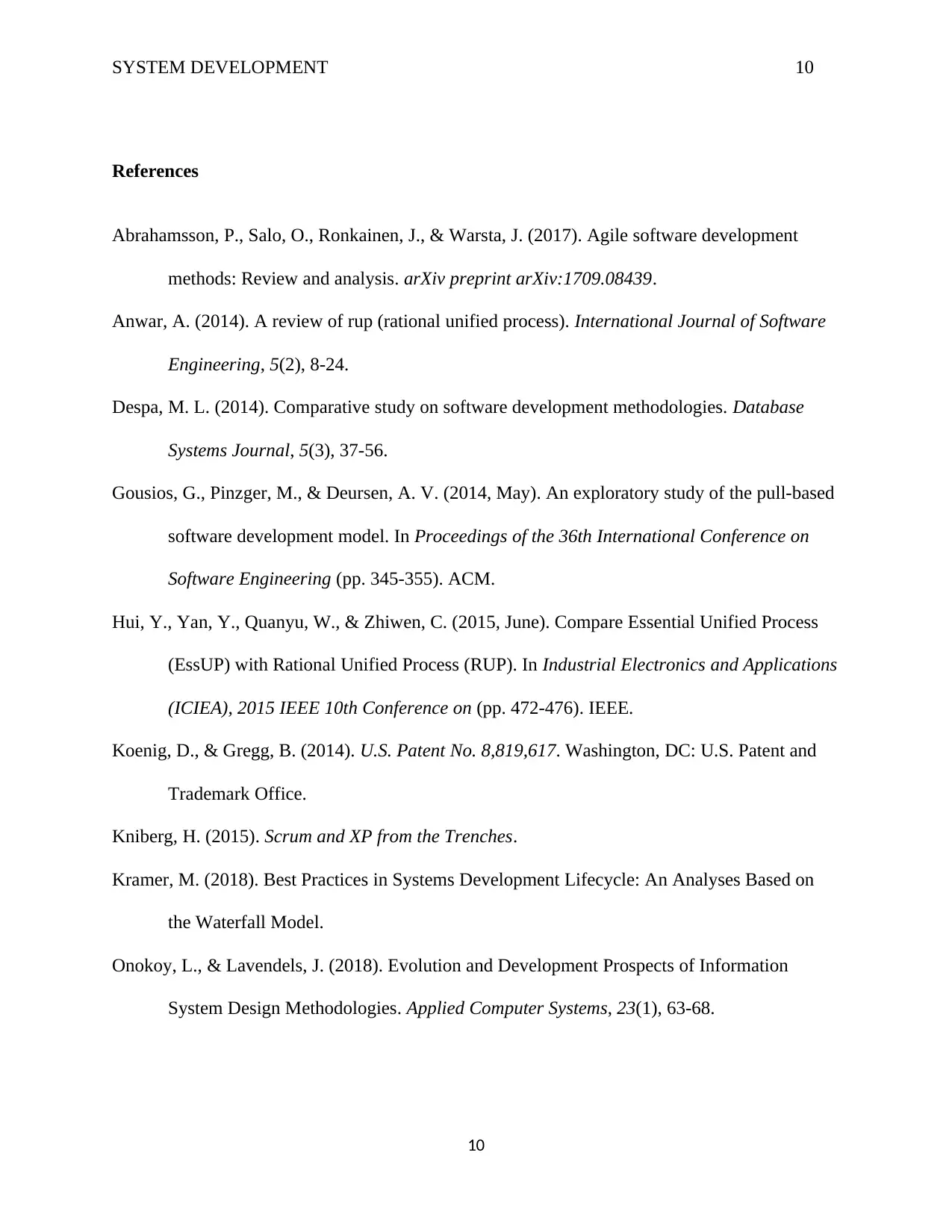
SYSTEM DEVELOPMENT 10
References
Abrahamsson, P., Salo, O., Ronkainen, J., & Warsta, J. (2017). Agile software development
methods: Review and analysis. arXiv preprint arXiv:1709.08439.
Anwar, A. (2014). A review of rup (rational unified process). International Journal of Software
Engineering, 5(2), 8-24.
Despa, M. L. (2014). Comparative study on software development methodologies. Database
Systems Journal, 5(3), 37-56.
Gousios, G., Pinzger, M., & Deursen, A. V. (2014, May). An exploratory study of the pull-based
software development model. In Proceedings of the 36th International Conference on
Software Engineering (pp. 345-355). ACM.
Hui, Y., Yan, Y., Quanyu, W., & Zhiwen, C. (2015, June). Compare Essential Unified Process
(EssUP) with Rational Unified Process (RUP). In Industrial Electronics and Applications
(ICIEA), 2015 IEEE 10th Conference on (pp. 472-476). IEEE.
Koenig, D., & Gregg, B. (2014). U.S. Patent No. 8,819,617. Washington, DC: U.S. Patent and
Trademark Office.
Kniberg, H. (2015). Scrum and XP from the Trenches.
Kramer, M. (2018). Best Practices in Systems Development Lifecycle: An Analyses Based on
the Waterfall Model.
Onokoy, L., & Lavendels, J. (2018). Evolution and Development Prospects of Information
System Design Methodologies. Applied Computer Systems, 23(1), 63-68.
10
References
Abrahamsson, P., Salo, O., Ronkainen, J., & Warsta, J. (2017). Agile software development
methods: Review and analysis. arXiv preprint arXiv:1709.08439.
Anwar, A. (2014). A review of rup (rational unified process). International Journal of Software
Engineering, 5(2), 8-24.
Despa, M. L. (2014). Comparative study on software development methodologies. Database
Systems Journal, 5(3), 37-56.
Gousios, G., Pinzger, M., & Deursen, A. V. (2014, May). An exploratory study of the pull-based
software development model. In Proceedings of the 36th International Conference on
Software Engineering (pp. 345-355). ACM.
Hui, Y., Yan, Y., Quanyu, W., & Zhiwen, C. (2015, June). Compare Essential Unified Process
(EssUP) with Rational Unified Process (RUP). In Industrial Electronics and Applications
(ICIEA), 2015 IEEE 10th Conference on (pp. 472-476). IEEE.
Koenig, D., & Gregg, B. (2014). U.S. Patent No. 8,819,617. Washington, DC: U.S. Patent and
Trademark Office.
Kniberg, H. (2015). Scrum and XP from the Trenches.
Kramer, M. (2018). Best Practices in Systems Development Lifecycle: An Analyses Based on
the Waterfall Model.
Onokoy, L., & Lavendels, J. (2018). Evolution and Development Prospects of Information
System Design Methodologies. Applied Computer Systems, 23(1), 63-68.
10
Paraphrase This Document
Need a fresh take? Get an instant paraphrase of this document with our AI Paraphraser
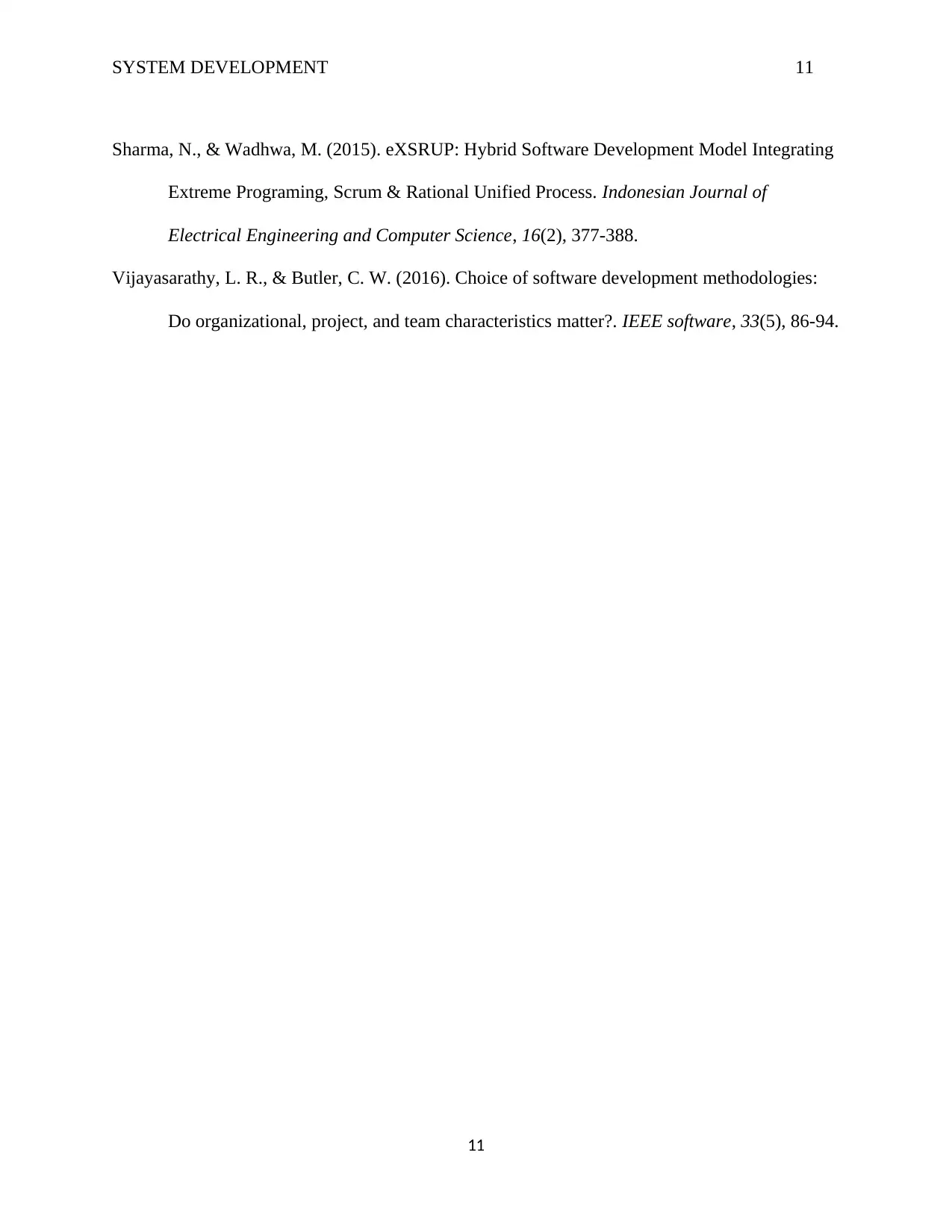
SYSTEM DEVELOPMENT 11
Sharma, N., & Wadhwa, M. (2015). eXSRUP: Hybrid Software Development Model Integrating
Extreme Programing, Scrum & Rational Unified Process. Indonesian Journal of
Electrical Engineering and Computer Science, 16(2), 377-388.
Vijayasarathy, L. R., & Butler, C. W. (2016). Choice of software development methodologies:
Do organizational, project, and team characteristics matter?. IEEE software, 33(5), 86-94.
11
Sharma, N., & Wadhwa, M. (2015). eXSRUP: Hybrid Software Development Model Integrating
Extreme Programing, Scrum & Rational Unified Process. Indonesian Journal of
Electrical Engineering and Computer Science, 16(2), 377-388.
Vijayasarathy, L. R., & Butler, C. W. (2016). Choice of software development methodologies:
Do organizational, project, and team characteristics matter?. IEEE software, 33(5), 86-94.
11
1 out of 11
Related Documents
Your All-in-One AI-Powered Toolkit for Academic Success.
+13062052269
info@desklib.com
Available 24*7 on WhatsApp / Email
![[object Object]](/_next/static/media/star-bottom.7253800d.svg)
Unlock your academic potential
© 2024 | Zucol Services PVT LTD | All rights reserved.





